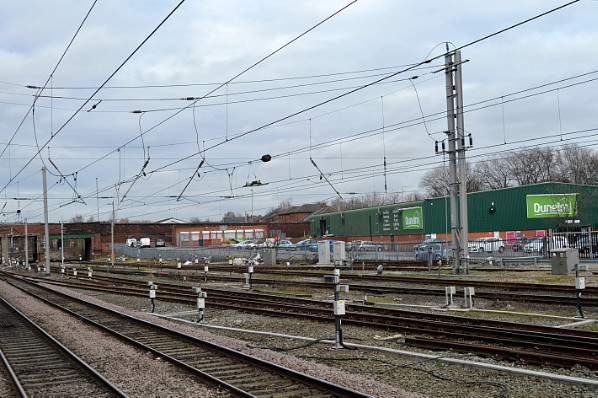
Station Name: WARRINGTON BANK QUAY (1st)[Source:
Paul Wright]
 Looking north towards Warrington in 1839 from the bridge that carried the GJR over the River Mersey. The station is out of sight in the distance but the town of Warrington can be seen on the horizon.
 
As an important regional centre the Grand Junction Railway provided extensive railway facilities at Warrington from the start. This map from the early 1850s shows the passenger station and the goods and servicing facilities that lay to the north.

The first Warrington Bank Quay station shown on a town plan from the early 1850s.
 An aerial view of the site of the first Warrington Bank Quay station taken in 1920. The station had been to the right of the bridge where a passenger train can be seen. The house like building surrounded by railway tracks had been the Patten Arms hotel and had existed at the time of the station. It can be seen on the town plan above. The access road to the first station can also be seen to the left of the Patten Arms. Hotel.Nothing survived of the station as the land had been utilised for extra sidings and tracks.
Reproduced with the kind permission of Simmons Aerofilms Ltd  A view looking north towards the site of the first Warrington Bank Quay station from the north end of the second station on 17 October 1953. The station was located adjacent to the bridge that can be seen in the distance. Passing through the first station site is a mixed goods train hauled by ex-LMS 2-8-0 8F locomotive number 48665. Photo by John Kirwood .jpg)
The site of the first Warrington Bank Quay station looking south on 21 April 2012. The station was in the foregroundand would have extended no further than the locomotive that is seen heading north on a ballast train. In the distance can be seen the second Warrington Bank Quay station.
Photo by Paul Wright  Looking north at the site of the first Warrington Bank Quay station on 18 February 2015. Photo by Terry Callaghan  A view looking north towards the site of the first Warrington Bank Quay station on 14 March 2015. Photo by John Wilson
|
 Warrington had been an important regional centre for centuries due to its strategic location as crossing point on the River Mersey; the bridge at Warrington was the most westerly road crossing until 1905. Because of its importance Warrington was provided with a substantial station on the western edge of the town. It was located on the south side of Bank Quay Bridge which passed over the line.
Warrington had been an important regional centre for centuries due to its strategic location as crossing point on the River Mersey; the bridge at Warrington was the most westerly road crossing until 1905. Because of its importance Warrington was provided with a substantial station on the western edge of the town. It was located on the south side of Bank Quay Bridge which passed over the line. 
 Home Page
Home Page